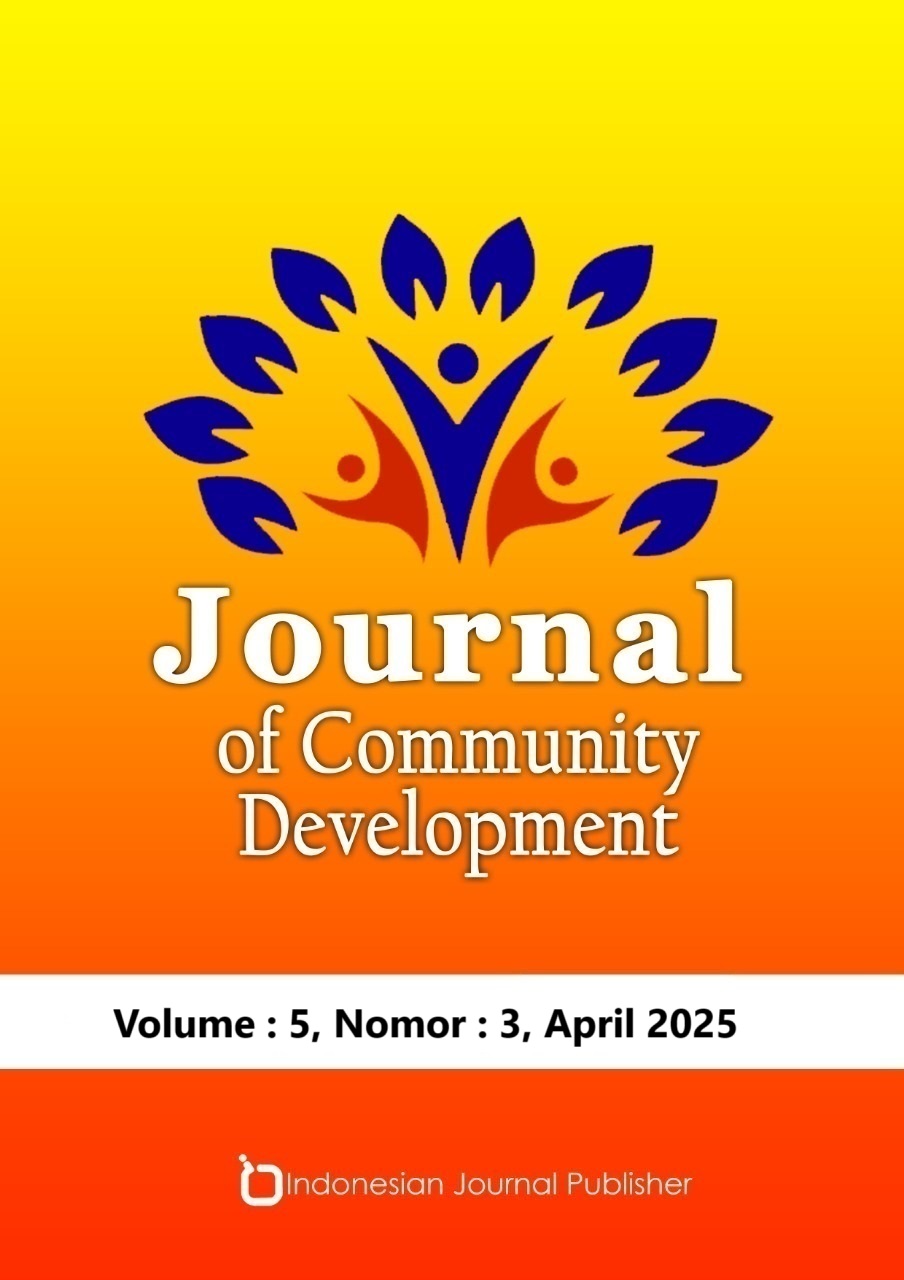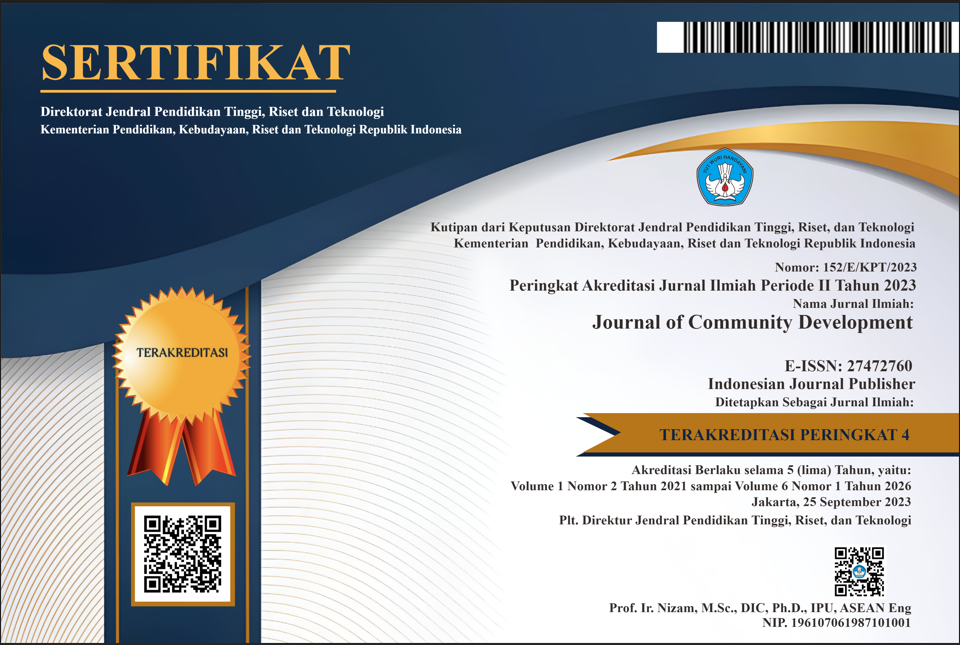Pendampingan Ibu Hamil Dalam Upaya Deteksi Dini Resiko Tinggi Kehamilan
DOI:
https://doi.org/10.47134/comdev.v5i3.287Keywords:
mentoring, pregnant women, high riskAbstract
The Maternal Mortality Rate (MMR) is a crucial indicator to assess public health, reflecting female deaths due to complications of pregnancy, childbirth, and postpartum per 100,000 live births. In Indonesia, MMR is still high, reaching 305 per 100,000 live births, mainly due to the lack of early detection of the high risk of pregnancy. Assisted activities for pregnant women in the Working Area of the Tirto I Health Center, Pekalongan Regency, to improve the detection and management of high-risk of pregnancy. This activity was carried out through a community empowerment program involving 32 pregnant women from Samborejo Village and Pandanarum Village, for eight months. The methods used include socialization, mentoring, and continuous education with the Islamic Religion and Health approach. The results of the activity showed an increase in pregnant women's knowledge about pregnancy risks, increased community participation, and early identification of risky medical conditions such as pre-eclampsia, KEK, anemia, and hypertension. Emotional and psychological support is provided through an Islamic values-based approach, which helps reduce stress and improve the mental health of pregnant women. Collaboration between the service team, village midwives, and health cadres strengthens efforts to detect and handle the high risk of pregnancy. This program successfully increased the knowledge of pregnant women by 13% and sufficient knowledge by 3% about the prenatal care. It reduced the risk of pregnancy complications, which ultimately contributed to the reduction of maternal mortality and infant mortality rates in the Tirto I Health Center Working Area.. Evaluation and follow-up show that the main goal is achieved and recommend future improvements. Efforts are needed to increase collaboration between various parties such as health offices, health centers, universities, and community organizations to create a stronger support network for early detection of high-risk pregnancies.
Downloads
References
Arso, S. P. et al. (2023) ‘Penguatan Peran Lintas Sektor Dalam Percepatan Penurunan Stunting Di Wilayah Kerja Puskesmas Tlogosari Kulon’, Jurnal Pengabdian West Science, 2(08), pp. 624–632. doi: 10.58812/jpws.v2i08.547.
DinKes Kabupaten Pekalongan (2022) ‘Profil Kesehatan Kabupaten Pekalongan Tahun 2022’. Pekalongan:DinKes Kabupaten Pekalongan, p. 74. Available at: https://drive.google.com/file/d/17ggp2vYJSWrpwima5-s5xNC_wcRNLt5Q/view.
Imron, A. et al. (2022) ‘Sinergi Lintas Sektor Dalam Percepatan Penurunan Stunting Di Kabupaten Nganjuk, Jawa Timur’, Jurnal Media Gizi Indonesia, 17(1SP), pp. 239–243. doi: 10.20473/mgi.v17i1sp.239-243.
Kementerian Kesehatan RI (2019) Buku Kesehatan Ibu dan Anak. Jakarta: Kementerian Kesehatan RI.
Novianti, N. and Suparmi, S. (2022) ‘Peran Dukungan Sosial Dalam Pelaksanaan Program Pendampingan Ibu Hamil Di 7 Kabupaten/Kota Di Indonesia’, Jurnal Kesehatan Reproduksi, 12(2), pp. 103–116. doi: 10.58185/jkr.v12i2.24.
Prasetyo, A. and Wulandari, I. (2022) ‘Program Berbasis Masyarakat untuk Deteksi Dini Risiko Kehamilan: Studi Kasus di Desa Sukamaju’, Jurnal Kesehatan Masyarakat, 14(1), pp. 55–67.
Rahayu, S. (2021) Peran Komunitas dalam Pendampingan Ibu Hamil dan Deteksi Dini Risiko Kehamilan. Yogyakarta: Universitas Yogyakarta.
Reddy, R. K. and Anjanappa, S. (2017) ‘Use of Mobile Applications for Prenatal Care’, Journal of Obstetrics and Gynecology, 37(1), pp. 25–30.
Sandall, J. et al. (2016) ‘Midwife-led Continuity Models Versus Other Models of Care for Childbearing Women’, Cochrane Database Syst Rev, 15(9). doi: 10.1002/14651858.CD004667.pub4.
Santoso, H. and Nugroho, M. (2023) Keterlibatan Masyarakat dalam Kesehatan Ibu dan Anak: Panduan untuk Program Komunitas. Jakarta: Sehat Mandiri.
Say, L. et al. (2014) ‘Global Causes of Maternal Death: A WHO Systematic Analysis’, Lancet Glob Health, 2(6), pp. e323–e333. doi: 10.1016/S2214-109X(14)70227-X.
Siregar, R. J. (2019) Edukasi Maternal Perspektif Al Qur’an. Disertasi. Institut PTIQ Jakarta.
Wahyuni, S. et al. (2022) ‘Peran Media Sosial Sebagai Upaya Promosi Kesehatan’, Jurnal Forum Kesehatan : Media Publikasi Kesehatan Ilmiah, 11(2), pp. 86–96. doi: 10.52263/jfk.v11i2.233.
Waluyo, H. (2023) ‘Angka Kematian Ibu dan Bayi di Kabupaten Pekalongan Masih Tinggi’, Radar Pekalongan. Available at: https://radarpekalongan.disway.id/read/39516/angka-kematian-ibu-dan-bayi-di-kabupaten-pekalongan-masih-tinggi.
Widiastuti, T., Kartasurya, M. I. and Dharminto (2014) ‘Manajemen Deteksi Dini Ibu Hamil Risiko Tinggi pada Pelayanan Antenatal di Tingkat Puskesmas Kabupaten Jepara’, Jurnal Manajemen Kesehatan Indonesia, 02(03), pp. 261–267. Available at: https://media.neliti.com/media/publications/112486-ID-none.pdf.
World Health Organization (2016) WHO Recommendations on Antenatal Care for A Positive Pregnancy Experience. Geneva: World Health Organization.
Yuniarti, F., Ratnawati, L. and Ivantarina, D. (2022) ‘Deteksi Dini Kehamilan Risiko Tinggi Melalui Edukasi dan Skrining Pada Ibu Hamil di Masa Pandemi Covid-19’, Jurnal Pengabdian kepada Masyarakat Nusantara, 3(1), pp. 89–101. doi: 10.55338/jpkmn.v3i1.290.
Downloads
Published
How to Cite
Issue
Section
License
Copyright (c) 2024 Lia Dwi Prafitri, Suparni, Gigih Setianto

This work is licensed under a Creative Commons Attribution 4.0 International License.







